Early Modern Information Visualization
I ran into a lovely bit of early modern information visualization today while reading a classic, Peter Parhsall’s and David Landau’s 1994 study The Renaissance Print, 1470-1550:

This diagram appears at the bottom of a lengthy broadside announcing a shooting contest in Cologne. The text describes the tournament setup: a course of three hundred “feet”. This being a time before the advent international standard measures, the print could not simply describe lengths and measures verbally. Hence the curious geometric shapes. With this broadside in hand, the budding contestant could measure out each foot themselves using the long printed crossbar. Moreover, they could even construct their own practice target by copying the printed circle, and inscribing concentric rings around it, spaced using the smaller of the bars.1
With this efficient visualization, the woodcut became both a bearer of news as well as a utilitarian tool. It not only described the event, but actually enabled the viewer to reconstruct the conditions of the contest using the print as a visual model.
-
David Landau and Peter W. Parshall, The Renaissance Print, 1470-1550 (New Haven: Yale University Press, 1994), 239–240. ↩
